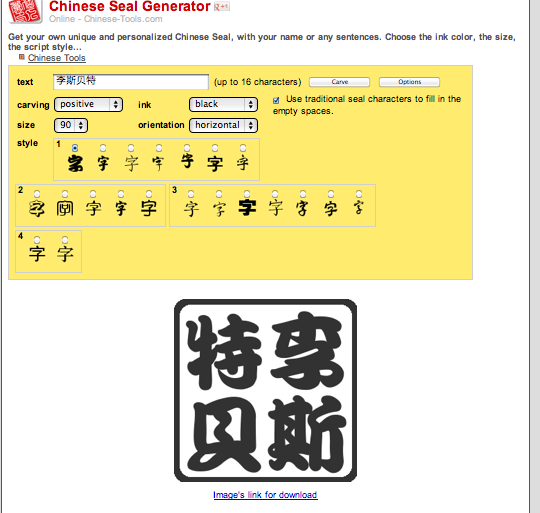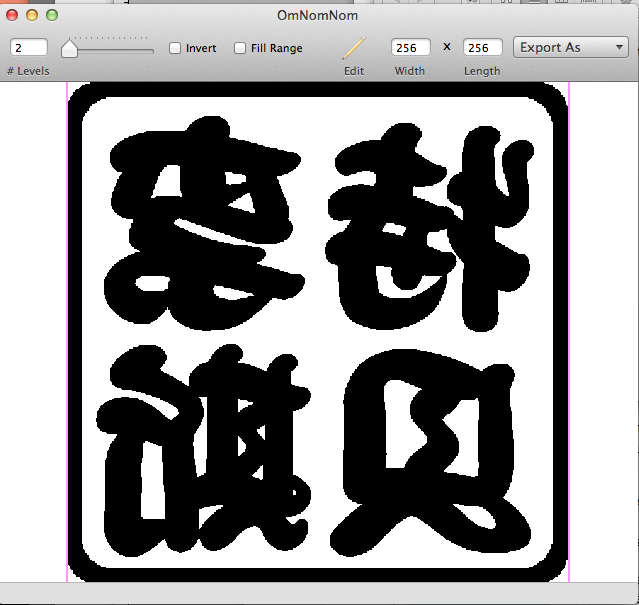Chinese Seals
Consider printing with flexible filament

Overview
Use 3D printing in the Engineering Design process to create unique chinese seals. This project supports STEM by using software and hardware to fabricate seals in a DIY manufacturing project.
Resources
- Chinese Name
- Seal Generator
- OmNomNom.dmg (Mac Only)
- Image Editing Software
- OpenSCAD
- MakerWare
Lesson Background
Chinese seals are typically made of stone, but sometimes they are made of wood. They are typically used with red ink or cinnabar paste. The colloquial name for a seal is a chop. This term was adapted from a Malay word during the colonization of the Straits Settlements.
East Asia currently uses a mixture of seals and hand signatures, and increasingly, electronic signatures. In Japan and China, seals are still commonly used and are used instead of a signatures when doing business or other procedures. In certain cases only seals are acceptable.
Types of Seals
- Zhuwen (朱文, lit. "red characters") seals imprint the characters in red ink, sometimes referred to as yang seals.
- Baiwen (白文, lit. "white characters") seals imprint the background in red, leaving white characters, sometimes referred to as yin seals.
-
Zhubaiwen Xiangjianyin (朱白文相間印, lit. "red-white characters combined seal") seals use zhuwen and baiwen together.
Name Seals 名印 Denote the person's name.
These seals are almost always square.
| Chinese | Pinyin | English | Example | Use |
| 姓名印 | Xingming Yin | Personal Name Seal | 李小狼 or 李小狼印 |
State the family and personal name of a person
|
| 表字印 | Biaozi Yin | Style Name Seal | 字矗昊 or 矗昊 |
State the style name of a person
|
| 臣妾印 | Chenqie Yin | Subject Concubine Seal | 臣美櫻 |
Used in imperial times by concubines or officials
|
| 書簡印 | Shujian Yin | Simplified Word Seals | 如佩信印 |
Used in letters, instead of writing well wishes by hand,
the seal takes its place
|
| 總印 | Zong Yin | General or Combined Seal | 大英伯明皇龍正之章 |
States the personal name and the place name where he/she
is from
|
| 迴文印 | Huiwen Yin | Rotating Character Seal | 徐永裕印 |
Same as the personal name seal, but characters are read in
an anti-clockwise direction, rather than from the top-down, right-to-left.
Sometimes used in writing (i.e. to sign a preface of a book, etc).
|
Free Seals 閑印are like online signatures, and can contain the person's personally philosophy or literary inclination.
These can be any shape, ranging from ovals to dragon-shaped.
| Chinese | Pinyin | English | Example | Use |
| 肖形印 | Xiaoxing Yin | Portrait Seal |
Has images with no words to express the users character
|
|
| 吉語印 | Jiyu Yin | Lucky Sayings Seal | 日就富貴 | Has lucky sayings and proverbs |
| 黃神越章 | Huangshen Yuezhang | Exceeding Seal of the Yellow God | 黃神越章天帝神之印 | Used in ancient times on letters as a protective charm on letters to ward off wild beasts and demons of the recipient. Now used mainly as a well-wishing convention on letters to people who travel abroad |
| 封泥 | Feng Ni | Sealing Stamp |
Used to seal letters or packages, often after the
sealing tag/strip has been stuck on the flap
|
Studio Seals 齋印 carry the name of the person's private studio 書齋, which most literati in ancient China had, although probably in lesser forms. These are more or less rectangular in shape.
| Chinese | Pinyin | English | Example | Use |
| 齋館印 | Zhaiguan Yin | Studio or Study Seal | 雅目齋 |
States the name of the studio or body. This includes
society and company seals
|
| 別號印 | Biehao Yin | Alias Seal | 白石道人 |
States aliases that the user uses. These include
artistic names, painting names, pen-names, etc
|
| 收藏印 | Shoucang Yin | Storage Seal | 松雨彗齋圖書印 |
Used on books or paintings that are kept by the user.
This includes appreciation seals used on paintings and books that the
owner admires
|
| 詞句印 | Ciju Yin | Poetry Seal | 問松消息 | Has poems or proverbs inscribed, used on paintings, etc. Size can range from big to small depending on how long the inscription is |
| 花押印 | Huaya Yin | Flower Signature Seal |
A mark used in place of a signature. Often small,
sometimes with images, the design can be varied in style
|
Seal Paste
There are two types of seal paste depending on what base material they are made of. One is silk based (mixed with cinnabar et al.) to form a very thick substance. The other is plant based to form a very loose substance.
Silk: The red paste is made from finely pulverized cinnabar, mixed with castor oil, and silk strands. The silk strands bind the mixture together to form a very thick substance. It has a very oily appearance and tends to be a bright red in color.
Plant: The red paste is made from finely pulverized cinnabar, mixed with caster oil, and moxa punk. Because the base is a plant one that has been pulverized, the texture is very loose due to the fact that it doesn't bind. The appearance is sponge like and not oily and tends to be a darker shade of red.
Usage—Most people in China possess a personal name seal. Artists, scholars, collectors and intellectuals may have a full set of several seals: name seals, leisure seals, and studio seals. A well-made seal made from semi-precious stones can cost between &Yen;400 - &Yen;4000.
Seals are still used for official purposes in a number of contexts. When collecting parcels or registered post, the name seal serves as an identification. Today, personal identification is often by a hand signature accompanied by a seal imprint. Seals can serve as as identification with signatures because they are difficult to forge and only the owner has access to his own seal.
Seals are also often used on Chinese calligraphy works and Chinese paintings, usually imprinted in such works in the order (from top to bottom) of name seal, leisure seal(s), then studio seal.
Seals are usually carved out by specialist seal carvers, or by the users themselves. Specialist carvers will carve the user's name into the stone in one of the standard scripts and styles. On the other hand, some people take to carving their own seals out of soapstone and fine knives, which are widely available and is cheaper than paying a professional for expertise, craft, and material. Results vary, but it is possible for individuals to carve perfectly legitimate seals for themselves.
Determining which side of the seal should face up may be done in a number of ways: if there is a carving on top, the front should face the user; if there is an inscription on the side, it should face to the left of the user; if there is a dot on the side, it should face away from the user.
Warm Up
Present information on Chinese Seals.
Lesson Sequence
- Translate your name into Chinese characters using Chinese-Tools.com
- Generate your seal using
Chinese-Tools.com's Chinese Seal Generator

- Open the downloaded file in a Editing Application like Photoshop. Flip the image:
Original Flipped 

- Open the flipped file in OmNomNom Generator

- Export seal as Logo and save the file.
- Make adjustments in OpenSCAD, compile and render (F6)
- Export STL and print.
